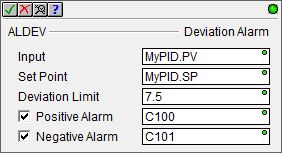Topic: DMD0001
ALDEV - Deviation Alarm
The Deviation Alarm instruction (ALDEV) monitors the Input and turns ON the selected alarm bit locations if the Input has changed (deviated) from the Set Point by more than the Deviation Limit. Both of the Alarm bits are turned OFF when the ALDEV instruction does NOT have power flow.

Parameters:
Note: Use the F9 key or click the 'three dot box' at the right edge of the parameter field to open the Default Element Selection Tool (the Element Picker or the Element Browser) or use the Down-Arrow key (Auto-Complete) on any parameter field to see a complete list of the memory locations that are valid for that parameter of the instruction.
Input is the memory location to monitor. This can be any readable numeric location.
Set Point is the value which the deviation is measured from. The Set Point can be any constant value or any readable numeric location.
Deviation Limitis the maximum allowable change of the Input value from the Set Point value. Deviation Limit can be any constant value or any readable numeric location.
If the Positive Alarm is enabled, this is the bit location to turn ON if the Input value is greater than the SetPoint by more than the Deviation Limit, otherwise the bit will be turned OFF. This can be any writable bit location.
If the Negative Alarm is enabled, this is the bit location to turn ON if the Input value is less than the SetPoint by more than the Deviation Limit, otherwise the bit will be turned OFF. This can be any writable bit location.
See Also:
ALDEV - Deviation Alarm
Related Topics:
Getting Started with PID Loops
Using the PID Process Simulator in the Do-more Simulator
Rung Example:

